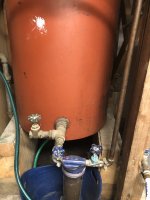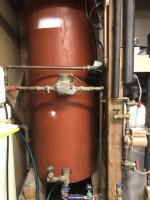Hi,
This will be the third time that we need to drain our huge 5' tall old bladderless tank, because every 6 months the pump will start to cycle, but we seem to forget what to do each time. There are no valves for attaching air compressor that we can find, although I think I remember getting an air compressor last time when I did it with the plumber.
There is a pipe from the pump from the holding tank that we can turn off at the valve.
There is a hole in the bottom of the tank to attach a hose to, which we can string along to a shower drain. And I think I remember opening the laundry faucet.
Any other tips? Should we open anything else? there is also a faucet fitting that sticks out the front of the tank we could open? It doesn't look like the top of the tank has been opened in the 60 yrs it's been in the house.
Thanks!
This will be the third time that we need to drain our huge 5' tall old bladderless tank, because every 6 months the pump will start to cycle, but we seem to forget what to do each time. There are no valves for attaching air compressor that we can find, although I think I remember getting an air compressor last time when I did it with the plumber.
There is a pipe from the pump from the holding tank that we can turn off at the valve.
There is a hole in the bottom of the tank to attach a hose to, which we can string along to a shower drain. And I think I remember opening the laundry faucet.
Any other tips? Should we open anything else? there is also a faucet fitting that sticks out the front of the tank we could open? It doesn't look like the top of the tank has been opened in the 60 yrs it's been in the house.
Thanks!
Attachments
Last edited:


